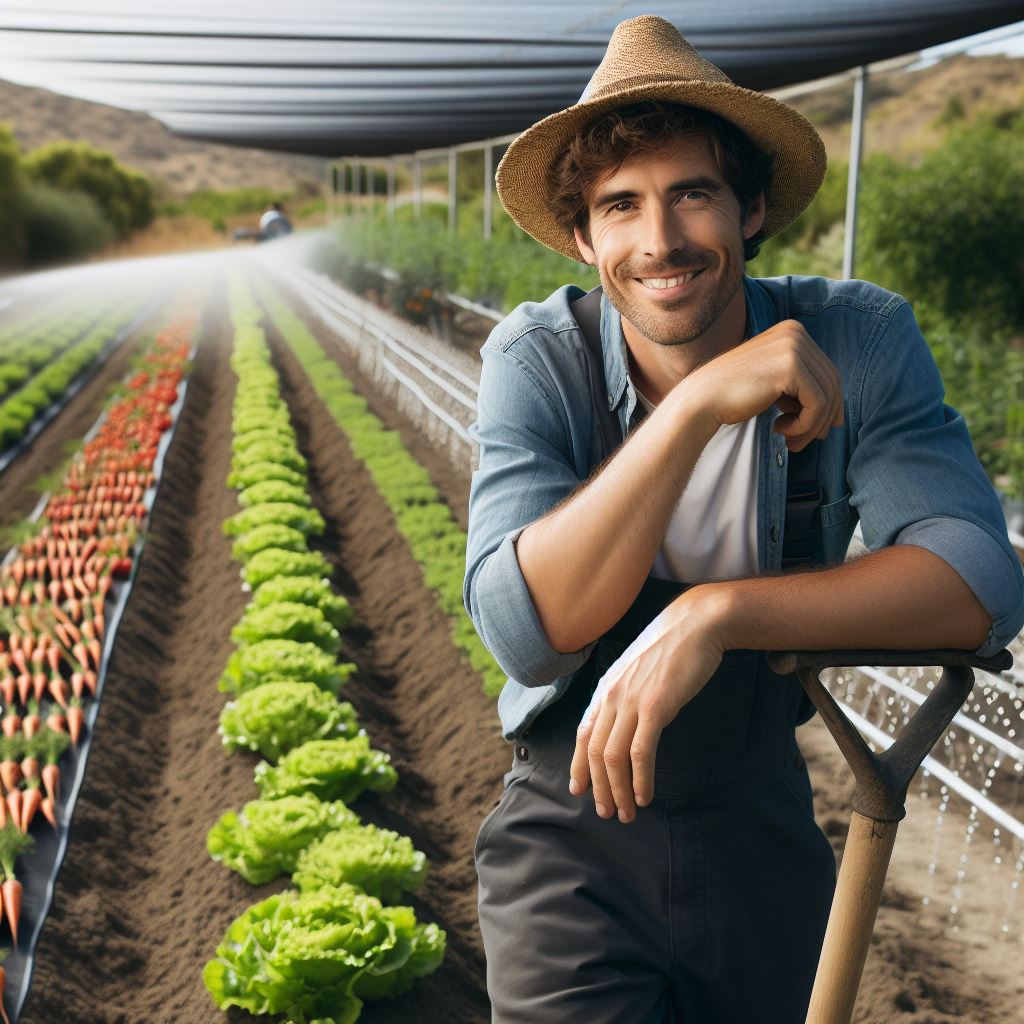Introduction
A. Climate-Smart Agriculture (CSA): A game-changer
CSA maximizes yields while minimizing environmental impact.
B. Water Conservation’s Crucial Role
- Vital for sustainable agriculture
- Mitigates water scarcity risks
- Shields against climate change impacts
C. Blog Focus: Water Conservation Tactics
- Precision Irrigation Techniques
- Rainwater Harvesting Systems
- Drip Irrigation Advancements
- Soil Moisture Monitoring Tools
- Crop Selection Strategies for Water Efficiency
In this section, delve into the essence of Climate-Smart Agriculture, highlighting its revolutionary impact on agricultural practices.
Recognize the paramount importance of water conservation and grasp the intricacies of the blog’s focus on tactical approaches to preserve this invaluable resource.
Discover how precision irrigation, rainwater harvesting, drip irrigation, soil moisture monitoring, and strategic crop selection collectively contribute to a sustainable and resilient agricultural future.
Understanding Water Conservation in Agriculture
A. Definition and significance of water conservation
Water conservation refers to the practice of using water efficiently to minimize wastage and protect this valuable resource.
It is of utmost significance in agriculture as it ensures sustainable production and supports food security.
B. The current challenges faced by agriculture regarding water scarcity
- Agriculture is highly dependent on water for irrigation and plant growth, but water scarcity is becoming a global concern.
- Climate change, increased population, and mismanagement lead to dwindling water resources.
- Farmers are struggling to cope with irregular rainfall patterns and the availability of water for irrigation.
C. The role of Climate-Smart Agriculture (CSA) in promoting water conservation
- CSA is an approach that aims to address the triple challenge of food security, climate change adaptation, and mitigation.
- CSA practices emphasize the sustainable use of water resources in agriculture.
- Precision irrigation techniques, such as drip irrigation and micro-sprinklers, reduce water wastage by targeting the roots and minimizing evaporation.
- Implementing water-efficient technologies, such as hydroponics and aeroponics, can significantly reduce water consumption in crop production.
- Using efficient water management strategies, such as rainwater harvesting and water recycling, maximizes water availability for agricultural activities.
- Crop diversification and selection of drought-tolerant varieties can also contribute to water conservation by reducing the water demand.
The integration of CSA practices and water conservation techniques can lead to several benefits:
- Increased water-use efficiency improves crop productivity and reduces production costs for farmers.
- Enhanced water availability ensures a more reliable and stable supply of water for agriculture, minimizing risks associated with water scarcity.
- The conservation of water resources supports ecosystem health and biodiversity, preserving natural habitats and water-dependent species.
- Water conservation practices contribute to climate change adaptation and mitigation efforts, as efficient water use reduces greenhouse gas emissions associated with energy-intensive irrigation systems.
In short, water conservation plays a vital role in sustainable agriculture.
The current challenges posed by water scarcity can be addressed through the adoption of CSA practices.
By implementing water-efficient technologies and management strategies, farmers can enhance water-use efficiency and contribute to food security and climate change resilience.
Embracing water conservation in agriculture not only ensures the long-term sustainability of our water resources but also supports the prosperity of farming communities and the protection of our environment.
Read: Innovative Farming: Using AI for Water Management
Water Conservation Tactics in Agriculture
A. Improved Irrigation Techniques
Water conservation tactics in agriculture are crucial for sustainable development.
Efficient irrigation techniques form the backbone of effective water management.
Drip irrigation, for instance, allows water to directly reach plant roots, ensuring minimal wastage.
Transform Your Agribusiness
Unlock your farm's potential with expert advice tailored to your needs. Get actionable steps that drive real results.
Get StartedPrecision sprinkler systems further enhance efficiency by evenly distributing water, reducing runoff.
B. Crop Rotation and Cover Cropping
Another essential tactic is crop rotation, which involves growing different crops in a specific sequence.
This method enhances water conservation by reducing disease and pest pressure and improving soil health.
Cover cropping, the growth of specific plants during fallow periods, is another effective approach.
Cover crops act as a protective layer, preventing evaporation and preserving soil moisture.
C. Soil Management Practices
Soil management practices also play a vital role in water conservation.
Conservation tillage methods, such as no-till or reduced tillage, minimize soil erosion and keep water within the fields.
Additionally, the presence of organic matter in the soil enhances moisture retention, promoting better water infiltration.
Mulching techniques, such as covering the soil with organic materials, further reduce evaporation and maintain soil moisture levels.
D. Agroforestry and Windbreaks
Agroforestry, the integration of trees and crops, offers multiple benefits for water conservation.
Trees provide shade, reducing evaporation from the soil and creating a microclimate that retains moisture.
Windbreaks, rows of trees or shrubs strategically planted to reduce wind speed, also help conserve water by minimizing evapotranspiration.
Implementing agroforestry and windbreaks together can lead to sustainable water management systems.
In fact, implementing water conservation tactics in agriculture is crucial for sustainable farming practices.
Transform Your Agribusiness Online Presence
Stand out with compelling content tailored to engage your audience and drive results. From blog posts to social media, we’ll create what your business needs to grow.
Get StartedImproved irrigation techniques, such as drip irrigation and precision sprinkler systems, minimize water wastage.
Crop rotation and cover cropping enhance soil moisture retention, while soil management practices like conservation tillage and mulching improve water infiltration and retention.
Agroforestry and windbreaks offer additional benefits, reducing evapotranspiration and providing sustainable water management solutions.
By utilizing these tactics, farmers can contribute to environmental preservation and ensure the long-term viability of their agricultural practices.
Read: Revolutionizing Agriculture with Greywater Usage

Explore Further: Organic Farming: Biodiversity’s Best Friend
Benefits and Challenges of Implementing Water Conservation Tactics
Implementing water conservation tactics in agriculture comes with a range of benefits and challenges.
Let’s explore them in more detail.
A. Environmental Benefits
1. Reduced water usage and conservation of water resources
By implementing water conservation tactics, farmers can optimize water usage and reduce their dependency on limited water resources.
This can help ensure the availability of water for future generations.
2. Preservation of soil quality and prevention of erosion
Water conservation tactics, such as drip irrigation and mulching, help maintain soil moisture levels and prevent erosion.
This leads to healthier soil, increased crop yields, and protects the land from degradation.
3. Mitigation of climate change impacts
Water conservation plays a crucial role in mitigating the effects of climate change.
By using water efficiently, farmers can contribute to reducing greenhouse gas emissions and minimizing the impact of droughts on agricultural production.
Unlock Farming Insights for Growth
Make smarter farming decisions with detailed reports on market trends, weather patterns, and soil health tailored to your farm's success. Boost productivity with actionable data.
Get ReportB. Economic and Social Benefits
1. Increased efficiency and cost savings
Implementing water conservation tactics improves overall farm efficiency by reducing water waste and associated costs.
Farmers can save money on water bills and invest those savings in other aspects of their operations.
2. Improved long-term viability of farming operations
Water scarcity is a growing concern in many regions.
By adopting water conservation techniques, farmers can ensure the sustainability and resilience of their farming practices for the future. This enhances their long-term viability.
3. Positive impacts on local communities
Water conservation in agriculture has ripple effects beyond individual farms.
Efficient water use leads to healthier ecosystems, which benefits the entire community.
Additionally, the promotion of sustainable agriculture practices can improve the reputation and image of local farming communities.
C. Barriers to Adoption
1. Initial investment costs and technological limitations
Implementing advanced water conservation tactics often requires initial investments in infrastructure and technologies.
Limited financial resources may hinder farmers’ ability to adopt such practices.
Additionally, some regions may lack access to suitable technology or expertise.
2. Lack of awareness and education about water conservation techniques
Many farmers may be unaware of the latest water conservation tactics available.
Limited access to information and education programs is a significant barrier to adoption.
Outreach and knowledge-sharing initiatives are crucial to address this challenge.
3. Potential resistance to change among farmers
Farmers may resist changing their traditional practices due to cultural or personal reasons.
Fear of disrupting established routines and skepticism about the effectiveness of new techniques can hinder the adoption of water conservation tactics.
Farmer-to-farmer knowledge exchange and demonstrations can help overcome such resistance.
In a nutshell, implementing water conservation tactics in agriculture brings various environmental, economic, and social benefits.
However, barriers such as high upfront costs, lack of awareness, and resistance to change need to be addressed to ensure widespread adoption.
The promotion of sustainable farming practices is essential for a more water-efficient and resilient agricultural sector.
Read: Water-Wise Farming: Top Crops for Arid Climates
Case Studies and Success Stories
A. Examples of successful water conservation practices
- Case study 1: Farmers in California using drip irrigation system reduced water usage by 40%.
- Case study 2: Organic farm in India saved 50% of water by implementing contour farming techniques.
- Case study 3: Australian vineyard adopted rainwater harvesting and witnessed a 30% decrease in water consumption.
B. Real-life experiences of farmers implementing these tactics
- A farmer in Nebraska shares how constructing terraces on his fields helped retain water during heavy rains.
- A rice farmer in Thailand discusses the positive impact of adopting alternate wetting and drying method in conserving water.
- A dairy farmer in New Zealand describes the successful implementation of urine-diverting toilets to reduce water pollution.
C. Quantifiable benefits observed in terms of water savings and increased productivity
- Case study 1: Wheat farmer in Kansas reduced water usage by 25% and experienced a 10% increase in crop yield.
- Case study 2: Vegetable farmer in Spain implemented mulching techniques, resulting in 20% water savings and higher-quality produce.
- Case study 3: Coffee plantation in Brazil used precision irrigation, saving 30% water while improving bean quality by 15%.
These case studies and success stories provide tangible evidence of the effectiveness of water conservation tactics in agriculture.
They demonstrate the potential for farmers to reduce water consumption, increase productivity, and improve sustainability.
Read: Sustainable Crops: Less Water, More Yield Strategies
Conclusion
Water conservation plays a crucial role in agriculture, ensuring the sustainability of our food production system.
Climate-Smart Agriculture is instrumental in promoting sustainable water management practices, ensuring the availability of water resources for future generations.
It is essential for readers to explore and adopt water conservation tactics in their farming practices to contribute towards a more sustainable and resilient agricultural sector.
Water conservation is of utmost importance in agriculture.
By implementing Climate-Smart Agriculture techniques, we can ensure the long-term availability of water resources and protect our environment.
It is everyone’s responsibility to explore and adopt water conservation tactics in their own farming practices.
Let’s work together to create a more sustainable and water-efficient agricultural sector for a better future.




